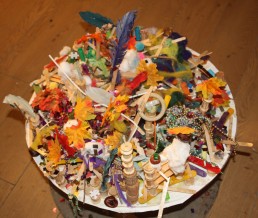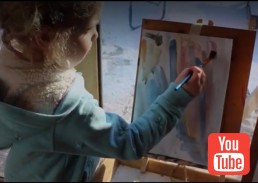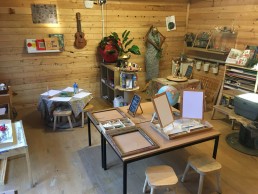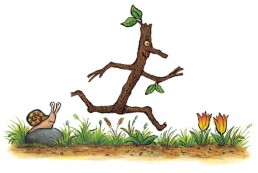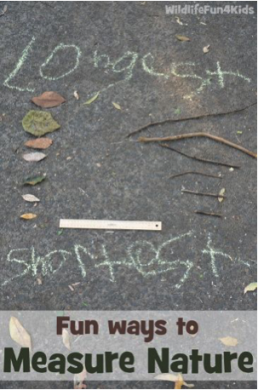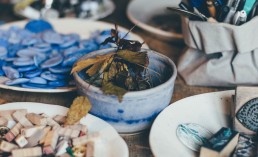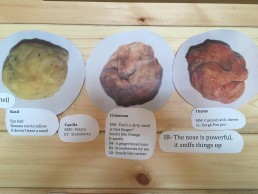The Sticking Table
Much more than just loose parts and glue
 Back in June, shape and structure created from loose parts became a shared interest, the children would make 2D shapes and arrangements with lolly pop sticks. Naturally this progressed into 3D shapes as the children explored the idea of building upwards with bobbins and corks added in.
Back in June, shape and structure created from loose parts became a shared interest, the children would make 2D shapes and arrangements with lolly pop sticks. Naturally this progressed into 3D shapes as the children explored the idea of building upwards with bobbins and corks added in.
We wanted to find a way of making these structures more permanent, a way of their models being able to interact with each other instead of standing alone on a shelf. From here the Sticking table was created!
An old repurposed cable reel became a platform for these structures and ideas to play out, and old objects took on new roles with the help of some glue, a lot of glue in fact.
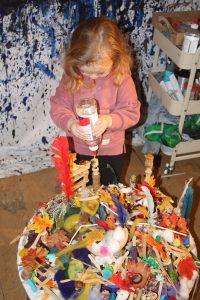

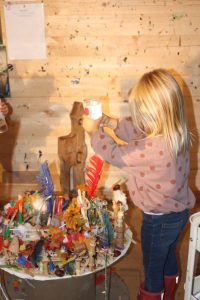
‘Sticky sticky glue’
The glue is poured from squirty bottles from heights, or from close distance, the children watch it pour and dribble. They watch how it builds up and falls off certain surfaces onto a surface below. They practice their aiming skills and try again when the glue doesn’t land where they had in mind. Children love being able to access resources them selves, the joy and independence they get from unravelling tape and pouring glue can’t always be fulfilled at home due to mess and waste, so this was the perfect place for them to pour glue to their hearts content. We used PVA, clear glue, old pen lids destined for the bin, feathers, wool, bobbins and sticks and each week the sticking table carried through with a new story.
The sticking table has been a house, a nest, a city, and a dragon house. For now the sticking table is going though a seasonal autumnal phase as conkers and leaves are added to the mix.
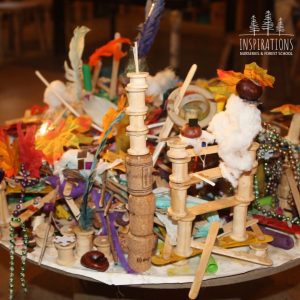
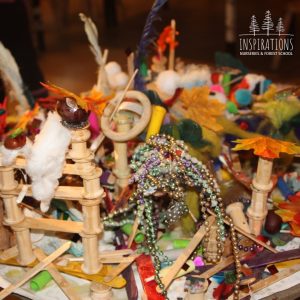
Having a long term project along side other activities can be a great way to allow children to practice and repeat skills, by revisiting ideas from weeks before they are able reflect on their ideas and build confidence. Schemas are a repeated pattern of behaviour that a child will go through whilst discovering how the world works. It is through this urge of repetition our children are given the time and opportunity to extend on their thinking and learning.
It can be hard as educators to have the chance to leave a project out, tidy up time is a necessity particularly in spaces where meal times take place. So the sticking table is the perfect place for them to come back to a scene that has not been tidied away from the last time they were in the Art Studio. The perfect opportunity for them to deepen their cognitive development. Because how else can our children reflect on their work and ideas when they return to a project that has been tidied away.
Only the children can predict where the sticking table will go next, but as each new group of creative minds come together to take ownership of it, it will, no doubt, take on a brand new adventure and identity over the coming weeks and months.
-Nathalie
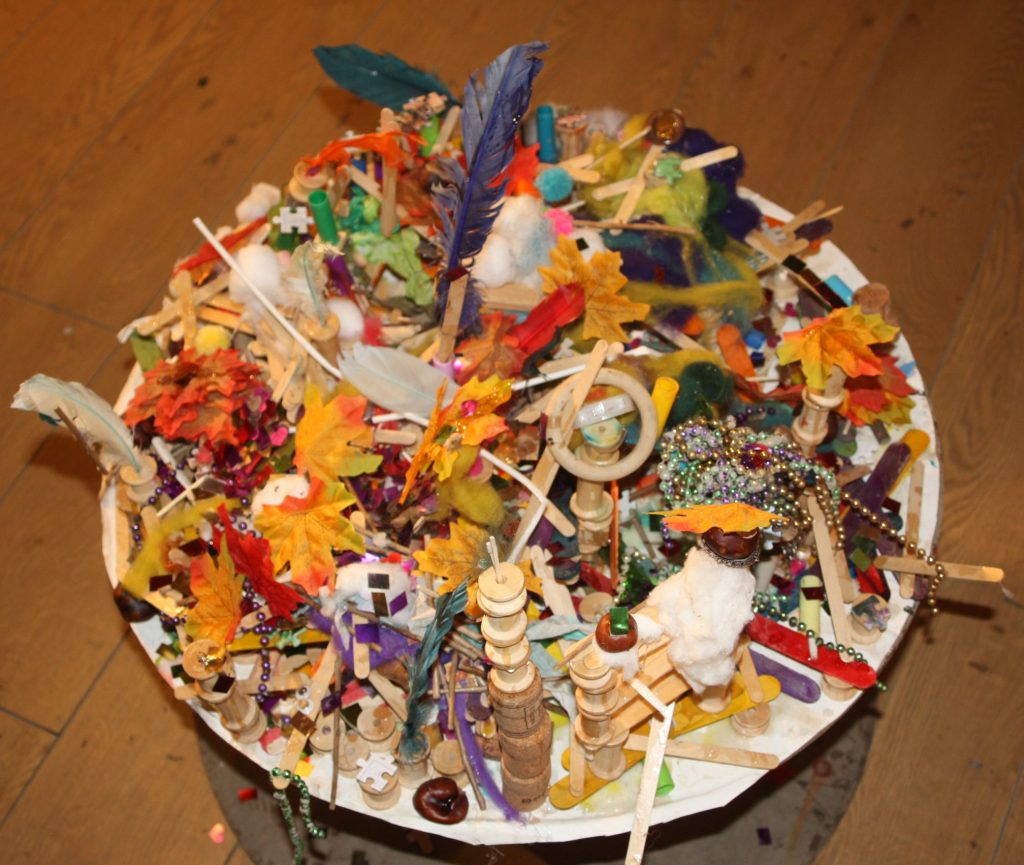
Seekers of Meaning
New Video
Over the last few weeks I have been filming the children as they explore the Art Studio. To read more about our Art studio you can go back to last weeks blog.
The children's current shared interest is construction and building houses from clay, bricks, sticks and blocks. Some of that is captured in our brand new video that you can watch here-
https://www.yout ube.com/watch?v=4-59qb9GgdQ
ube.com/watch?v=4-59qb9GgdQ
The Art Studio
Every morning and afternoon our Pre-Schoolers choose where they want to spend their time, between the Yurt/Outdoor Classroom, Forest School or the Art Studio. There is a quaint pebbled path that leads us behind the Yurt, past the new pond and up to this purpose built creative space, but this isn't just any art classroom, we do things a little differently here. http://simonr30.sg-host.com/the-art-room/
Why do we have an Art Studio?
Of course creativity is woven throughout every aspect of our learning at Inspirations, there are mark making tools, paints and clay accessible in all areas, so why do we need an additional separate creative space? The Art Studio, (referred to as an Atelier in the Reggio culture) is so much more than just an Art Room. It is its own separate space for the children to own, re-purpose and re-visit week after week, and is set out to foster self discovery.
100 Languages of Learning
It is a space for smaller groups of children to branch off, be heard, share ideas, and develop the confidence to be leaders of their own research and learning. It is an environment that plays host to books, materials and tools that support the 100 ways of learning with the support of myself as the Atelierista. It is a space where children proceed through their inquiry to reach their hypothesis though guided experiments, mixed media, play, music, light and shadow, sculpture and dramatic play. A space for them to give meaning to, give identity to, and in turn put them selves and their ideas into context within the world they live in.








The walls of the Art Studio are a canvas, a projector screen, an art exhibition and a metaphorical mirror reflecting the evolving learning journey of our children. Through photos and quotes of the children's voice on the wall the children can see where their ideas started, where they are now, and by reading back the children's own words they see that their inputs are recorded, valued and remembered.
It's also important to note that the Atelierista is not an art teacher, rather, an Artist who knows the potential of art materials and children, and the limitless possibilities when these are combined.




Beautiful Mistakes
In the Art Studio the children are not afraid to try new things, because fear of failure doesn't exist. How can it exist in a place where mistakes are simply learning opportunities. A fallen glue pot can become an art project in its self, and a drawing gone wrong can inspire new ideas. One project that stands out began when a child wiped up spilt watercolour paint from the floor with a baby wipe and watched as the colours soaked through the wipe. He then decided to add baby wipes to a canvas, the 'dirty' baby wipes themselves then becoming the art.
Seekers of Meaning
As constant seekers of meaning, our children are making sense of the world around them with everything they do, and our Art studio is one section of our pre-school that fosters this.
This week we will be filming inside the Art Studio to see their explorations brought to life, this short film will be shared on You Tube next week.
- Nathalie
Home School Activity 3- Make Your Own Stick Man
Implementation
Resources: Sticks
Use the different sized sticks you’ve collected to make a Stick Man.
How will you join them together?
What could you use for his eyes?
Take a photograph of your Stick Man and share it with us!
Intent- Learning Objectives
Moving and Handling
22-36 months
- Shows control in holding and using jugs to pour, hammers, books and mark-making tools.
- Beginning to use three fingers
30-50 months
- Uses one-handed tools and equipment
40-60 months
- Uses simple tools to effect changes to materials.• Handles tools, objects, construction and malleable materials safely and with increasing control.
Literacy
22-36 months
- Has some favourite stories, rhymes, songs, poems or jingles
30-50 months
- Describes main story settings, events and principal characters.• Shows interest in illustrations and print in books and print in the environment.
40-60 months
- Uses vocabulary and forms of speech that are increasingly influenced by their experiences of books.• Enjoys an increasing range of books.
Being Imaginative
22-36 months
- Beginning to use representation to communicate, e.g. drawing a line and saying ‘That’s me.’
30-50 months
- Captures experiences and responses with a range of media, such as music, dance and paint and other materials or words.
40-60 months
- Creates simple representations of events, people and objects.
Exploring and using media and materials
30-50 months
- Joins construction pieces together to build and balance.• Realises tools can be used for a purpose.
40-60 months
- Understands that different media can be combined to create new effects. • Manipulates materials to achieve a planned effect.• Constructs with a purpose in mind, using a variety of resources.• Uses simple tools and techniques competently and appropriately.• Selects appropriate resources and adapts work where necessary.• Selects tools and techniques needed to shape, assemble andjoin materials they are using.
Technology
30-50 months
- Knows how to operate simple equipment, e.g. turns on CD player and uses remote control
Impact-
How did this activity go? Please use this space to record any findings, adaptions, reflections and quotes from your children. We would love you to email them back to us or share them on Tapestry, Instagram or Facebook.
Home School Activity 2: Sticks
Resources: Sticks
Implementation
We see a lot of you found sticks during your scavenger hunt, so using these sticks, encourage your children to look at the sizes of them and ask what they can see.
 Support them if necessary to place the sticks into size order using mathematical language of size and length, long, short, biggest, smallest, medium etc.
Support them if necessary to place the sticks into size order using mathematical language of size and length, long, short, biggest, smallest, medium etc.
Extension – using a stone, hands, Lego or what your child believes would be appropriate, (trial and error and problem solving) you could measure the sticks and record your findings with any representation suitable with your child’s ability, such as drawing pictures, taking photographs, writing digits.
Intent- Learning Objectives-
Here's what your children will get out of this activity, within their age brackets.
Maths- Shape, Space and Measure
22-36 months
- Beginning to categorise objects according to properties such as shape or size.
- Begins to use the language of size
30-50months
- Uses positional language.
40-60 months
- Orders two or three items by length or height
PSED – Personal, Social, Emotional Development
30-50 months
- Can select and use activities and resources with help.
- Welcomes and values praise for what they have done.
- Enjoys responsibility of carrying out small tasks.
- Shows confidence in asking adults for help.
40-60 months
- Confident to speak to others about own needs, wants, interests and opinions.
- Can describe self in positive terms and talk about abilities.
Impact- Please use this space (or a sheet of paper) to record any findings, adaptions, reflections and quotes from your children. We would love you to email them back to us or share them on Tapestry.
Happy Measuring.
The VIN Team (Virtual Inspirations Nursery)
Reggio Emilia At Home
Dear Parents, this is the first of many posts aimed to help those of you who are at home with your children. We will be providing daily activities for you to do with your children at home, and we would love to hear back from you every step of the way. Keep checking our Facebook posts and our Instagram stories for updates and share your findings on tapestry.
Overview of Reggio Emilia
One type of learning that many parents have adapted for use in the home-school setting is the Reggio Emilia approach. The Reggio Emilia approach to early childhood is a long used and well-respected technique used by educators and parents around the world. Reggio Emilia is a method, which requires no special training, just an understanding of basic principles.
In a nutshell, there are a few ideals that guide Reggio classrooms, and these can be easily transferred into the home setting. This philosophy was first developed in the 1960’s in Reggio Emilia, Italy, as a means to create an atmosphere to truly develop children’s intelligence and desire to learn. In this approach children were seen as highly capable, curious leaners, who are capable of constructing their own learning.
Reggio Materials
Open-ended items from nature play an important role in the Reggio inspired classroom. Pinecones, stones, shells, sticks, bark and leaves can be used for many purposes. Children can create from them, examine them, and use them to represent concepts. To have a large amount of stones for example will encourage maths, counting, making shapes, building, imagination and communication. The use of loose parts will keep your children occupied, investigating and using their imagination and problem solving ideas.

Other open-ended types of materials may include a collection of wooden blocks, scraps of fabric, a basket of scarves, ceramic tiles or mosaic glass pieces, cardboard tubes, or any other type of material that children may be interested in. You may be very interested to watch what children will create with everyday items
Activity One
Scavenger Hunt- One of the first things you could do with your children is to go on a resources hunt in the garden, attic or garage for any of the items above. We look forward to seeing your findings on tapestry, and remember almost anything can be classed as a loose part.
Principles of Reggio Emilia
This approach works on a few guiding principles, and parents who are seeking to implement a Reggio inspired home-school can use these as a guideline for their ‘classroom’.
- The child should have some control over their own learning. They should be allowed to develop and follow their own interests.
- Learning is best acquired through a multi sensory approach. Touching, listening, seeing, hearing and moving allow children to thoroughly understand.
- Teachers/parents are mentors and guides, but not the keepers of all knowledge. They should work alongside the children to ensure true understanding, but keep in mind that the learning process should be primarily child led.
- The environment is seen as the ‘third teacher’. Materials are carefully selected and rooms are free of clutter. Natural light, order and beauty are hallmarks of a Reggio classroom.
- Project based learning is encouraged. Instead of isolating subject areas, students are encouraged to truly research their interests from many angles. Whatever they choose to learn about can be read about, written about, painted, built etc.
- Documentation is paramount. One highlight of the Reggio approach is the importance it places of documentation. Examples of student work are highly visible. Teachers record children’s thoughts and conversations to then showcase them to make their thinking visible.
- Communication is imperative. In the Reggio approach, children are talked with, listened to, and respected. They are encouraged to use language to explore, and in the early years, sounds rhyme and rhythm are toyed with. Later, rich conversations drive much of a child’s learning.
- The One Hundred Languages of Children: One of the most important ideals driving the Reggio Emilia philosophy is referred to as the Hundred Languages of Learning. This means that children have many different ways to express their thoughts and learning. Hands- on learning and play are ways that children can demonstrate their learning, along with song, dance, drawing, writing, painting, physical activity, pretend play and story telling, just to name a few. Each of these activities are seen as valid methods of learning about the world and work together to compose an entire child.
Mirrors
 One hallmark to the Reggio approach is the use of mirrors throughout the play/work area. Mirrors are used not only on the walls, but also on surfaces to provide another point of view and depth of understanding. Children who are building with blocks can see their structure from a new perspective when a mirror is placed next to it. Children working with stones can see it from all angles when working on a mirrored surface. Using mirrors adds a new depth to children’s inquiry. When selecting mirrors for your home-school, you should keep the child’s age in mind. Very young children may need to use acrylic mirrors as a safety precaution as they may lean on them during their play, causing breakage.
One hallmark to the Reggio approach is the use of mirrors throughout the play/work area. Mirrors are used not only on the walls, but also on surfaces to provide another point of view and depth of understanding. Children who are building with blocks can see their structure from a new perspective when a mirror is placed next to it. Children working with stones can see it from all angles when working on a mirrored surface. Using mirrors adds a new depth to children’s inquiry. When selecting mirrors for your home-school, you should keep the child’s age in mind. Very young children may need to use acrylic mirrors as a safety precaution as they may lean on them during their play, causing breakage.
Inquiry Based learning
One of the best ways to determine ideas for study is by listening to the questions your children ask, or observing them while they are playing. Perhaps they said “It is so cool that water turns into the shape of my bucket when I pour it”, or “why don’t you ever see bats in the daytime?”. These simple conversations can lead to some of the best lessons you can do with your child. Stock your work area up with books about matter or nocturnal animals. Follow your child’s lead.
Once you have stumbled upon a topic that seems to grab your child’s attention, look for ways for them to explore it. Provide them with materials that can deepen their understanding and allow them to express themselves in one of the one hundred ways.
 The number one most important thing a home-school parent needs to remember is to follow the child. If they are not interested, they will not be engaged and very little true learning will occur. Often time, parents will see an activity that they think looks interesting or a book that they find beautiful only to be disappointed in their child’s lack of curiosity in the topic.
The number one most important thing a home-school parent needs to remember is to follow the child. If they are not interested, they will not be engaged and very little true learning will occur. Often time, parents will see an activity that they think looks interesting or a book that they find beautiful only to be disappointed in their child’s lack of curiosity in the topic.
Reggio Emilia is one great philosophy to adapt to a home-school setting. It is not expensive to implement, requires no specialised training, and is very flexible. Remembering a few simple principles will allow you to follow the lead of your child, and maximise their academic potential as well as foster a curious nature and a love of learning.
The Inspirations Home School Team
Thinking Outside The Box
'Colour is a power that directly influences the soul'- Wasily Kandinsky
At Inspirations, children always think outside the box. Just the other day when a group of preschoolers were making scented playdough during their art session, a child exclaimed; “Smells are like things you can smell but you smell them and you see it in your eyes”. When another added that smells can be seen, lovely smells as well as bad smells.
As a Senior Educator I am required to make sure that the preschool provision fits relevant standards set and recommended by Ofsted, Early Years Foundation Stage, Health and Safety regulations, Safeguarding and Child Protection, UNCRC, Children Acts etc. I have forms and tick lists for absolutely everything. My life has become a policy and a procedure easily entered into a Microsoft Spreadsheet, whereas a child’s view of life is magnificent, limitless and without bounderies. And I am not referring to imagination. The child from the art session was not using imagination when linking smells to vision, she was critically evaluating; using the skill needed for graduate-level research.
So often, the education systems forgets that children are pools of limitless knowledge that can not be defined by regulations, tick lists and spreadsheets. This made me reflect, if smells can be seen, can our feelings be defined by something other than smiley and sad faces; the traditional representation of feelings and emotions in a typical nursery setting? Why do we tend to simplify everything in order for children to gain understanding if the understanding is already there? Maybe it’s actually us, the practitioners that need to open their eyes to smells..
Therefore, I’ve decided to rebel against the traditional thinking and broaden our own understanding of life through the eyes of three and four year olds. I am looking forward to exploring the spectrum of feelings and thoughts through the use of colours. I believe, it was the founder of abstract art forms, Wassily Kandinsky who said that colour is a power that directly influences the soul, lets see if he is right.
Michaela- Pre-School Room Leader



